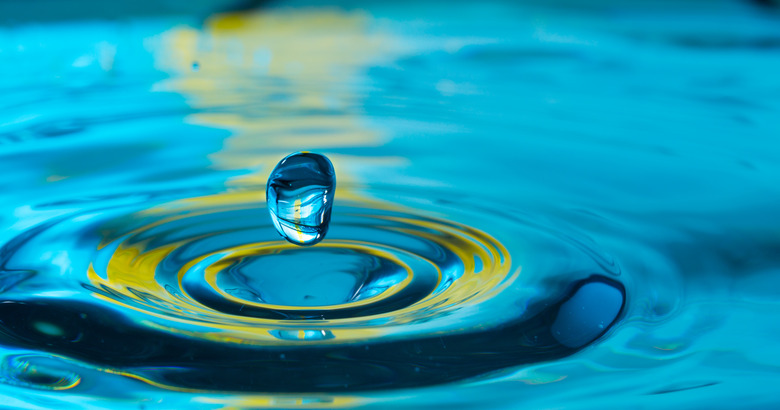Importance Of Hydrogen Bonding
Hydrogen bonding is important in many chemical processes. Hydrogen bonding is responsible for water's unique solvent capabilities. Hydrogen bonds hold complementary strands of DNA together, and they are responsible for determining the three-dimensional structure of folded proteins including enzymes and antibodies.
An Example: Water
An Example: Water
A simple way to explain hydrogen bonds is with water. The water molecule consists of two hydrogens covalently bound to an oxygen. Since oxygen is more electronegative than hydrogen, oxygen pulls the shared electrons more closely to itself. This gives the oxygen atom a slightly more negative charge than either of the hydrogen atoms. This imbalance is called a dipole, causing the water molecule to have a positive and negative side, almost like a tiny magnet. Water molecules align so the hydrogen on one molecule will face the oxygen on another molecule. This gives water a greater viscosity and also allows water to dissolve other molecules that have either a slightly positive or negative charge.
Protein Folding
Protein Folding
Protein structure is partially determined by hydrogen bonding. Hydrogen bonds can occur between a hydrogen on an amine and an electronegative element, such as oxygen on another residue. As a protein folds into place, a series of hydrogen bond "zips" the molecule together, holding it in a specific three-dimensional form that gives the protein its particular function.
DNA
DNA
Hydrogen bonds hold complementary strands of DNA together. Nucleotides pair precisely based on the position of available hydrogen bond donors (available, slightly positive hydrogens) and hydrogen bond acceptors (electronegative oxygens). The nucleotide thymine has one donor and one acceptor site that pairs perfectly with the nucleotide adenine's complementary acceptor and donor site. Cytosine pairs perfectly with guanine through three hydrogen bonds.
Antibodies
Antibodies
Antibodies are folded protein structures that precisely target and fit a specific antigen. Once the antibody is produced and attains its three-dimensional shape (aided by hydrogen bonding), the antibody will conform like a key in a lock to its specific antigen. The antibody will lock onto the antigen through a series of interactions including hydrogen bonds. The human body has the capacity to produce over ten billion different types of antibodies in an immunity reaction.
Chelation
Chelation
While individual hydrogen bonds are not very strong, a series of hydrogen bonds is very secure. When one molecule hydrogen bonds through two or more sites with another molecule, a ring structure known as a chelate is formed. Chelating compounds are useful for removing or mobilizing molecules and atoms such as metals.
References
Cite This Article
MLA
Contributor, . "Importance Of Hydrogen Bonding" sciencing.com, https://www.sciencing.com/importance-hydrogen-bonding-2514/. 5 April 2018.
APA
Contributor, . (2018, April 5). Importance Of Hydrogen Bonding. sciencing.com. Retrieved from https://www.sciencing.com/importance-hydrogen-bonding-2514/
Chicago
Contributor, . Importance Of Hydrogen Bonding last modified August 30, 2022. https://www.sciencing.com/importance-hydrogen-bonding-2514/
